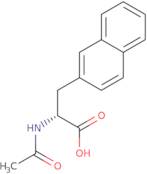Acetyl-3-(2-naphthyl)-D-alanine
CAS: 37440-01-0
Ref. 3D-FA48147
| 1g | Ausgelaufen | ||
| 2g | Ausgelaufen | ||
| 5g | Ausgelaufen | ||
| 500mg | Ausgelaufen |
Produktinformation
- Ac-D-Ala(2-naphthyl)-OH(R)-N-Acetyl-2-naphthylalanine
- (2R)-2-(acetylamino)-3-naphthalen-2-ylpropanoate
- (2R)-2-Acetamido-3-naphthalen-2-ylpropanoic acid
- (R)-2-Acetamido-3-(naphthalen-2-yl)propanoicacid
- (R)-2-Acetylamino-3-(2-naphthyl)propanoic acid
- (r)-2-Acetamido-3-(naphthalen-2-yl)propanoic acid
- (αR)-α-(Acetylamino)-2-naphthalenepropanoic acid
- 2-Naphthalenepropanoic acid, α-(acetylamino)-, (R)-
- 2-Naphthalenepropanoic acid, α-(acetylamino)-, (αR)-
- Ac-D-2-Nal-OH
- Mehr Synonyme anzeigen
- N-Acetyl-D-2-naphthylalanine
Acetyl-3-(2-naphthyl)-D-alanine (AADA) is a synthetic analog of the natural hormone insulin-like growth factor 1 (IGF-1). It has been shown to inhibit cancer cell growth and proliferation in culture. IGF-1 receptors are present on the surface of cells, which bind to IGF-1 and stimulate cell growth. AADA binds to IGF-1 receptors, blocking their activation by IGF-1 and preventing cancer cells from proliferating. It is also a potent inhibitor of cellular acetylation, which may be part of its mechanism of action. Acetylation is an important process in the regulation of gene expression and protein function.
AADA inhibits the production of epidermal growth factor (EGF) and other related proteins by binding to them before they can be activated. This prevents EGF from activating its receptor, which leads to decreased synthesis of EGF. AADA does not affect the production or activity of





